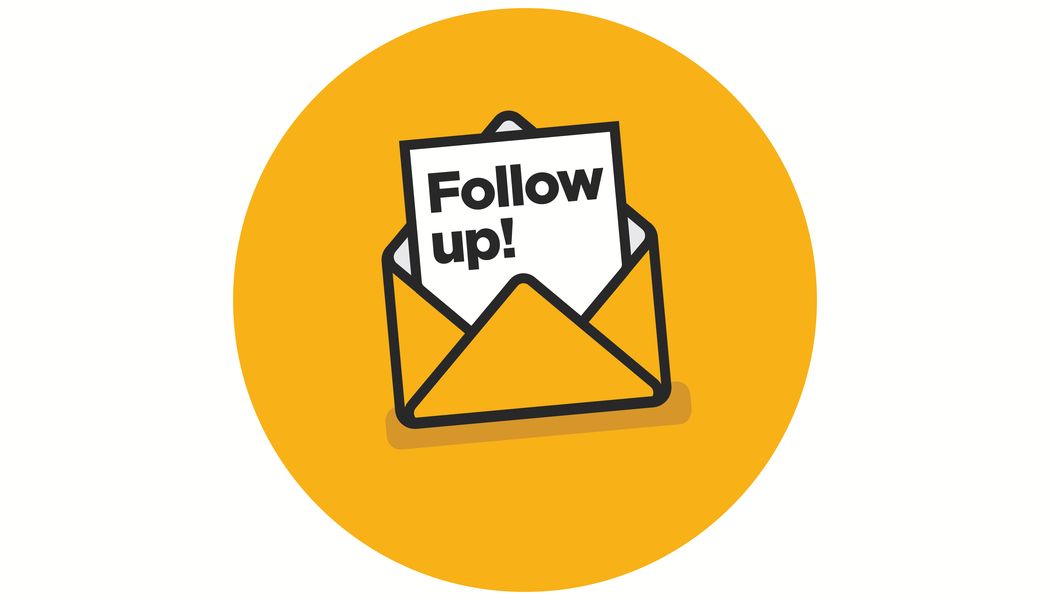Follow-Ups After No Response
How to Write a Follow Up Email
The thought of writing a follow up message can make you feel uncomfortable. This happens because our instincts tell us that if a person is not interested, they probably won't reply to an email at all, and they will obviously not like it if you bother them again. Despite the fact that in some cases it may be true, the majority of people can be unresponsive after the initial message for various other reasons. They might have not seen the message at all, they've seen it but got busy and haven't responded, they may be sick, and so on. Therefore, sending follow-up emails is essential in any sales outreach. In fact, according to the studies, the response rate is often higher on the second follow up email after no response and even on the third one rather than on the initial email or the first follow up.
When You Should Follow Up

Frequency and timing are crucial factors when it comes to writing follow up messages. It's proven that around 90% of business messages are opened and read within the 24 hours from the time they are sent. Consequently, around 90% of the responses you'll receive within the same time period. However, this doesn't mean that you need to write a follow up message right after these 24 hours have passed, because you'll likely appear too spammy and ruin the relationships with your prospects. Instead, it'd be much more productive to send the first follow up a couple of days after the initial message. The same goes for the next follow ups until the campaign is over. It's also recommended to increase the time span between the follow ups the more of them you send. Thus, the average campaign should last at least a week and a half or two.
The number of follow up messages is also very important. According to various researches, 1-4 follow up messages is optimal, depending on the campaign objective and the importance of the target.
How To Start A Follow Up Email

First of all, before sending a follow message, it's recommended to do thorough research and learn more about the person or the company you're trying to reach. The preliminary steps are to search for that person on social media (e.g. LinkedIn) and to visit that company's website and to try to find any information that may be appropriate to use in your message. In doing so, you'll show your potential clients that you've done your research and you're sure that what you're offering is beneficial for them.
Here’s A Follow Up Email Example
"I've just been looking at {Company}'s website and noticed {A}, {B}, {C}. So, I'm curious if you're currently looking for this type of a service, as our company provides just that. We {write about what your company is best at and how it can benefit prospect's company}."
This is a polite follow up email sample, in which you demonstrate that you’ve done your homework and know what their company is all about. And only after that, you write to them about your company and explain how they can benefit from your cooperation.
Crafting A Subject Line
The next step would be to think of a subject line to your message that does not sound spammy and demonstrates the value of your offer right away. The key to a great subject line is relevance and personalization. In that case, your subject line will definitely stand out and instantly show a person why they should spend their time opening and reading your message. Another option is to use a subject line that is unusual and draws attention. However, it should still be relevant to the subject matter of your message.
Here’re Some Good Subject Line Examples
- {subject matter} is the new oil
- About your blog post…
- Question about website
- Hi {Name}, question?
- Did you get what you were looking for?
- Hoping to help, Idea for {pain point}
- a message for {Name} about {pain point}
The Subject Matter
The next step is to give context to your message by explaining clearly and concisely why you're emailing them and what you need from them. You can even divide your prospects into two categories: those who opened your email and those who did not. To check it, you can enable email tracking either in the CRM you're using or install a special extension on your browser. This will also help you understand if your emails are getting through to your prospects. Thus, for those who opened your email, you should write a follow up containing some additional information about the product/service you're offering, and you can add one more reason why you're reaching out to them. As for those who didn't open the original message, it's better to include the same components which were in that message.
Follow Up Email Template For Those Who Opened The Message
“I just wanted to follow up to ask if you had a chance to look through the info I sent you previously. I’d be happy to hear your thoughts on that.
I’d also like to mention that our company {additional information}. In addition, I’ve attached our {some materials, like presentations, flyers, etc} to this message for the better understanding of our {services} and how they can benefit {prospect’s company}”
Why Should I Care?
Another important step in crafting a successful follow up message is to answer the question why the person you're emailing to should care about your message. In other words, on what benefits they can count. People are very often self-centered - especially when dealing with people they don't know. Moreover, if you add the busy schedule of business people into the equation, their desire to help out some stranger decreases considerably. Therefore, the value that your message brings to your prospects should be demonstrated as clearly as possible.
A Cold Email Follow Up Example Focused On The Reason Why You’re Emailing
“I understand that {pain point} can be rather challenging. That is why, we specialize in doing exactly that for companies like yours. So, I would be more than happy to set you up with a premium account for free so you can try {our services} out.”
Do Not Forget About A Call-To-Action

The next step is adding a strong call-to-action (CTA). At first, creating a good CTA can seem difficult, as your prospect doesn't know you personally, and you cannot refer to some previous interactions with them. In this case, it's better to be rather straightforward by specifying the value of your product to the prospect and asking them if they have 30 minutes available for a meeting to discuss it in more detail.
A great CTA is a powerful tool in crafting a successful message, primarily because they make it easier and clear for a prospect to take the next steps - as they are highlighted. Therefore, strong CTAs significantly increase the chance of the prospect getting back to you.
Here’re Some Examples Of Strong CTAs
- Are you available for a 30 mins chat on either Wednesday or Thursday?
- How about a brief call next Tuesday or Friday?
- Would you be open for a quick call on Monday or Tuesday to discuss how this could benefit {prospect's company}?
- Can I steal you away for a 30-minute call either on Wednesday or Friday to discuss how this might work for you?
Do Not Waste Your Time
One more important step in writing a follow up email is automating your sequence. Regardless of the campaign you're running being large or small, you'll still spend a lot of time on repeatable tasks. You can take them out of the picture by utilizing various tools for the email sequence automation that are available on the market. You'll still make personalized messages for your prospects, but the follow up emails you create beforehand, will be sent automatically with the intervals you have set.
How to Diversify Your Channels
Another important element in creating a follow up is using an omni-channel approach. Certainly, there's usually one channel for communication that is preferable, but this doesn't mean that other channels aren't worth giving a try. In this case, apart from the usual mailbox approach, you can also try reaching out to your prospects via social media (e.g. LinkedIn, Facebook, Instagram, Twitter, etc.) and via phone. This will increase the chance of receiving a response from them.
Summing Up
Now you should have the foundation to create a successful follow up message. It's important to bear in mind that cold emailing is all about trial and error. In other words, don't expect quick results without testing and trying different elements and understanding what urges people to open your message and reply to it.

